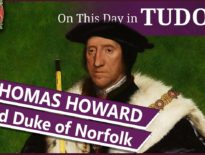On this day in Tudor history, 26th August 1555, Queen Mary I and her husband, Philip of Spain, departed from Whitehall in preparation for Philip's return to the Low Countries.
This was an awful time for Mary I. She had just come out of confinement after months of believing she was pregnant, and now her husband was leaving her. He'd be gone for over 18 months.
Find out more about Mary's state of health and mind, the arrangements for Philip's departure, and Mary's reaction, in today's talk.
Also on this day in Tudor history, 26th August 1533, Queen Anne Boleyn, second wife of King Henry VIII, prepared for the birth of her first child by "taking her chamber" at Greenwich Palace. This child was of course the future Queen Elizabeth I. “Taking her chamber” was common practice in Tudor England, and I explain all of the rituals and traditions involved in last year’s video:
Also on this day in history:
- 1539 – Death of Piers Butler, 1st Earl of Ossory and 8th Earl of Ormond, Lord Deputy of Ireland and a man known as “Red Piers”. He died at Kilkenny Castle and was laid to rest in the chancel of St Canice's Cathedral, Kilkenny.
- 1549 – The Earl of Warwick received 1,000 mercenaries as reinforcements to fight the rebels of Kett's Rebellion.
- 1552 – Death of Sir Clement Smith, administrator, brother-in-law of Jane Seymour and Lord Treasurer's Remembrancer from 1539 until his death. He died at Little Baddow in Essex.
- 1570 – Death of Thomas Thirlby, Bishop of Westminster and of Ely, at Lambeth Palace. He was deprived of his sees in 1559 due to his Catholic sympathies, and then imprisoned in the Tower in 1560. He was eventually released into house arrest at Lambeth, where he spent his last years. Thirlby was buried in the parish church at Lambeth.
- 1613 – Death of George Owen of Henllys, Welsh antiquary, author, naturalist, Deputy Lieutenant of Pembrokeshire and High Sheriff of Pembrokeshire, in Haverfordwest. He was buried at Nevern church. His works include “The Description of Penbrokshire”.
Transcript:
On this day in Tudor history, 26th August 1555, Queen Mary I and her husband, Philip of Spain, departed from Whitehall in preparation for Philip's return to the Low Countries.
This was just a month after daily processions and prayers for Mary’s safe delivery of the child she thought she was carrying had been cancelled, and just over three weeks since she’d come out of confinement at Hampton Court Palace and the royal court had moved to Oatlands. There was no baby. The months of praying and waiting had come to nothing. Although Mary’s body had swelled, her breasts had enlarged and produced milk, she just wasn’t pregnant. It must have been such a blow to her and Philip.
On 19th August 1555, the Venetian ambassador, Giovanni Michieli, recorded “Last week their Majesties returned to Hampton Court, the Lady Elizabeth remaining at the seat to which she went; and now the Queen shows herself and converses with everybody as usual, her health being so good as perhaps never to have been better, to the universal surprise of all who see her, but of delivery or pregnancy small signs are visible externally, and no one talks or thinks of them any longer.”
With the months of waiting having come to an end, Philip arranged to leave for the Low Countries, where he was needed. He was, however, worried about breaking the news to his already devastated wife, writing to one of his chief advisors: “Let me know what line I am to take with the Queen about leaving her and about religion. I see I must say something, but God help me!”
On 26th August 1555, the king and queen rode through London. Merchant -tailor and diarist Henry Machyn recorded:
“The 26 day of August came from Westminster, riding through London unto Towers-wharf, the King and the Queen, and there they took their barge unto Greenwich, and landed at the long bridge, and received by my lord chancellor, and my Lord of Ely, and my lord Viscount Montagu, master comptroller, master Southwell, and diverse more, and the guard, and diverse holding torches burning, and up to the Friars, and there their graces made their prayers, and at her grace’s landing received 9 or 10 supplications, and so back again to the court with a 100 torches burning.”
The Venetian ambassador wrote of them leaving Hampton Court instead, recording:
“Their Majesties came hither from Hampton Court yesterday morning, remaining merely to dine, and then went to Greenwich, where the Queen will remain during the whole time of the King's stay beyond sea. On departing hence, his Majesty had determined, when passing through London, to show himself in public to the people on horseback, leaving the Queen to follow him at leisure by water as usual, but her Majesty chose to give the City the satisfaction of seeing her likewise in his company, she having made the determination when in the very act of embarking; so having herself carried in an open litter, she went, accompanied not only by the English and Spanish nobility now at the court, but also by the Cardinal Legate and the ambassadors, the Lord Mayor and all the aldermen having met her at Temple Bar coming with the royal insignia and all the other solemnities, as customary when the Queen appears in public. It is not to be told what a vast crowd of people there was all along the road, which is a very long one, nor yet the joy they demonstrated at seeing their Majesties, which was really great, and the more as the London populace were firmly convinced that the Queen was dead; so when they knew of her appearance, they all ran from one place to another, as to an unexpected sight, and one which was well nigh new, as if they were crazy, to ascertain thoroughly if it was her, and on recognising and seeing her in better plight than ever, they by shouts and salutations, and every other demonstration, then gave yet greater signs of their joy, inasmuch as to their great comfort and that of her Majesty they saw her come with the King on one side of her and Cardinal Pole on the other, both of whom are universally popular by reason of the reported kindness of their nature, and of which daily proof is afforded by facts, so that the determination to make this display, most especially at the present moment, has been very useful.”
It was important to Mary that she how her people that she was alive and well. However, despite the joy of her people, Mary was depressed at the thought of Philip leaving her. The Venetian ambassador noted: “In the meanwhile, as may be imagined with regard to a person extraordinarily in love, the Queen remains disconsolate, though she conceals it as much as she can, and from what I hear mourns the more when alone and supposing herself invisible to any of her attendants.”
The Venetian ambassador went on to explain that Philip planned to stay at Greenwich until his fleet was ready and waiting at Dover. On 29th August, Philip left for Dover, accompanied by a party of English nobles and soldiers. He reached Sittingbourne on that day, “where he was received with great demonstrations of honour, having been met three miles in advance by the Lord Warden, Captain of the Cinque Ports, and Lord Lieutenant (Governator) of Kent, with a company of gentlemen of the county, in number 200, all on foot, clad in one livery; and on entering the town they found tables prepared in the streets as a mark of rejoicing, everybody being boarded and lodged gratis.” Then, he travelled to Canterbury, where she stopped to wait for news from his admiral on the arrival of the Flemish ships that were due to act as his escort on his crossing to Dover.
The Venetian ambassador records how the queen acted on Philip’s departure:
“Much to my pleasure I accompanied Cardinal Pole and the other noblemen on the day when they went with the King to his barge, to see him take leave of the Queen, who on that occasion really expressed very well the sorrow becoming a wife, and a wife such as she is, invested with the regal habit and dignity, for without displaying much extrinsic disquietude, though evidently deeply grieved internally, she chose to come with him through all the chambers and galleries (sale) to the head of the stairs, constraining herself the whole way to avoid, in sight of such a crowd, any demonstration unbecoming her gravity, though she could not but be moved when the Spanish noblemen kissed her hand, and yet more, when she saw the ladies in tears take leave of the King, who, according to the custom of the country, kissed them one by one. On returning, however, to her apartments, placing herself at a window which looks on the river, not supposing herself any longer seen or observed by any one, it was perceived that she gave free vent to her grief by a flood of tears, nor did she once quit the window until she had not only seen the King embark and depart, but remained looking after him as long as he was in sight; and the King on his part mounted aloft on the barge in the open air, in order to be better seen when the barge approached in sight of the window, and moreover, waived his bonnet from the distance to salute her, demonstrating great affection. Now whilst his Majesty is at Canterbury, not only every day, but every hour, expresses are on the road from the King to the Queen, and in like manner from hence to his Majesty, the gentlemen-in-waiting being always booted and spurred ready for a start.”
While Philip was away, Mary had arranged for her Archbishop of Canterbury and good friend, Cardinal Reginald Pole, to lodge with her “that he may comfort her and keep her company, Her Majesty delighting greatly in the sight and presence of him”. And Pole wrote to Philip of how Mary was spending her days, passing “the forenoon in prayer after the manner of Mary, and in the afternoon admirable personates Martha, by transacting business.”
Sadly, Philip was away for over 18 months, only arriving back in England on 20th March 1557, being greeted by a gun salute, bells ringing out, banquets, dances and masques. He hadn’t returned for his queen, though, he’d returned because he needed money and English support for a campaign against France. War was what he was after. This wasn’t what Mary’s council wanted, but they were dragged into supporting Spain and it was a disaster for England, leading to the loss of Calais in January 1558, a territory that England had held since the mid 14th century. Poor Mary.



Leave a Reply